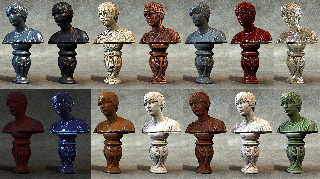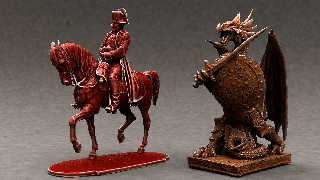 |
 |
|
 |
|
 |
|  |
|  |
|
 |
|
 |
|  |
|  |
|
 |
Recent posts here renewed my interest in proximity patterns.
After trying some methods, the best (in this setup) was that from ABX / Michael
Andrews (Death of a Cliche ...
http://news.povray.org/povray.binaries.scene-files/attachment/%3C3CC3D3E5.38B9F487@reading.ac.uk%3E/).
Some others are good in other situations (e.g. Samuel T. Benge
http://news.povray.org/povray.binaries.images/message/%3Cweb.4ed596b125fc27e89341ac0a0%40news.povray.org%3E/#%3Cweb.4ed
596b125fc27e89341ac0a0%40news.povray.org%3E
or Jim Charter Ruined
http://news.povray.org/povray.binaries.images/message/%3C46808234%40news.povray.org%3E/#%3C46808234%40news.povray.org%3
E)
- of course I didn't forget mesh camera of JVP or the DF3 method of Edouard.
Here I used Rune's Illusion code with a pregenerated "proximity map".
A file with more than 20 "prox mats" will be published after some cleanup.
Norbert
Post a reply to this message
Attachments:
Download 'proximity mats.jpg' (695 KB)
Preview of image 'proximity mats.jpg'

|
 |
|  |
|  |
|
 |
From: Thomas de Groot
Subject: Re: More materials based on proximity patterns
Date: 4 Oct 2017 02:53:35
Message: <59d4856f$1@news.povray.org>
|
|
 |
|  |
|  |
|
 |
On 3-10-2017 15:13, Norbert Kern wrote:
> Recent posts here renewed my interest in proximity patterns.
>
Excellent! It is good to have a choice according to the initial
conditions, or so I have learned. An overview of the different methods
is important too.
--
Thomas
Post a reply to this message
|
 |
|  |
|  |
|
 |
From: Thomas de Groot
Subject: Re: More materials based on proximity patterns
Date: 4 Oct 2017 07:47:57
Message: <59d4ca6d$1@news.povray.org>
|
|
 |
|  |
|  |
|
 |
Aside: I have been playing a bit with object patterns but I must confess
that I do not understand them... :-/
--
Thomas
Post a reply to this message
|
 |
|  |
|  |
|
 |
|
 |
|  |
|  |
|
 |
Thomas de Groot <tho### [at] degroot org> wrote:
> Aside: I have been playing a bit with object patterns but I must confess
> that I do not understand them... :-/
>
> --
> Thomas
One would assume that you've checked out FM's pages:
http://www.f-lohmueller.de/pov_tut/tex/tex_560e.htm
http://www.f-lohmueller.de/pov_tut/tex/tex_561e.htm
http://www.f-lohmueller.de/pov_tut/tex/tex_562e.htm
It looks like it's analagous to texture vs inside_texture in that it chooses one
texture or another. With this, it's not what "side" it on, it's whether or not
the point is any part of the object or not at all.
So presumably a[nother] good test scene would be a small object inside a
transmissive sphere - with the sphere representing the outside environment of
the object, and the object the inside.
[As with the rest of life] I find the pictures very helpful in understanding
what's going on. When it's all text and I have to sound it out, people think
I'm talking to myself in some made up language... org> wrote:
> Aside: I have been playing a bit with object patterns but I must confess
> that I do not understand them... :-/
>
> --
> Thomas
One would assume that you've checked out FM's pages:
http://www.f-lohmueller.de/pov_tut/tex/tex_560e.htm
http://www.f-lohmueller.de/pov_tut/tex/tex_561e.htm
http://www.f-lohmueller.de/pov_tut/tex/tex_562e.htm
It looks like it's analagous to texture vs inside_texture in that it chooses one
texture or another. With this, it's not what "side" it on, it's whether or not
the point is any part of the object or not at all.
So presumably a[nother] good test scene would be a small object inside a
transmissive sphere - with the sphere representing the outside environment of
the object, and the object the inside.
[As with the rest of life] I find the pictures very helpful in understanding
what's going on. When it's all text and I have to sound it out, people think
I'm talking to myself in some made up language...
Post a reply to this message
|
 |
|  |
|  |
|
 |
|
 |
|  |
|  |
|
 |
Am 04.10.2017 um 13:47 schrieb Thomas de Groot:
> Aside: I have been playing a bit with object patterns but I must confess
> that I do not understand them... :-/
They're pretty simple:
- Just like the `brick` or `checker` patterns, the `object` pattern is a
"choose one of two" pattern (as opposed to a "choose from a map" pattern
like `gradient`).
- You specify an arbitrary solid shape (may be CSG) to govern the actual
pattern, and every point in pattern 3D coordinate space is textured
according to whether it would be inside that shape or outside.
Think of this pattern as follows:
- Take the object specified in the pattern.
- Using vacuum forming, create a template from the pattern object.
- Discard the pattern object.
- Pour material A into the template.
- Pour material B around the template.
This creates a solid block, partially made from material A, and
partially made from material B, which is now your texture (or pigment).
- From the resulting block, carve an entirely different shape (the
actual object that uses the `object` pattern)
Post a reply to this message
|
 |
|  |
|  |
|
 |
|
 |
|  |
|  |
|
 |
"Norbert Kern" <nor### [at] t-online de> wrote:
> Recent posts here renewed my interest in proximity patterns.
That's some wild stuff there. Brings a whole new dimension to that one object.
Going to those past messages about this sort of thing shows what I was missing
out on when I decided to do more RL things (sightseeing motorcycle rides for
one).
I must make more of my own (even if feeble) attempts at this proximity pattern
thing too!
Thanks for the look!
Bob de> wrote:
> Recent posts here renewed my interest in proximity patterns.
That's some wild stuff there. Brings a whole new dimension to that one object.
Going to those past messages about this sort of thing shows what I was missing
out on when I decided to do more RL things (sightseeing motorcycle rides for
one).
I must make more of my own (even if feeble) attempts at this proximity pattern
thing too!
Thanks for the look!
Bob
Post a reply to this message
|
 |
|  |
|  |
|
 |
From: Thomas de Groot
Subject: Re: More materials based on proximity patterns
Date: 5 Oct 2017 03:00:07
Message: <59d5d877$1@news.povray.org>
|
|
 |
|  |
|  |
|
 |
On 4-10-2017 17:46, clipka wrote:
> Am 04.10.2017 um 13:47 schrieb Thomas de Groot:
>> Aside: I have been playing a bit with object patterns but I must confess
>> that I do not understand them... :-/
>
> They're pretty simple:
>
Thanks Clipka and Bald Eagle; I indeed forgot to consult FL ;-)
I fully understand now.
--
Thomas
Post a reply to this message
|
 |
|  |
|  |
|
 |
|
 |
|  |
|  |
|
 |
Thank you for the comments.
I just downloaded the demo file with 25 proximity materials on
povray.binaries.scene-files
(http://news.povray.org/povray.binaries.scene-files/thread/%3Cweb.59d7a90b58cfc649473ac47e0%40news.povray.org%3E/).
It's a 4 part download because of mesh size.
By the way - here is another render with 2 extremely large meshes (600 MB for
the Napoleon statue and 400 MB for the dragon figure in mesh2 formate).
It took several trials with different PoseRay versions to transform the basic
obj files (coming from Artec 3D -
https://www.artec3d.com/3d-models/art-and-design).
What are your experiences with large models - are there ways to improve
stability of the mesh conversion?
Regards
Norbert
Post a reply to this message
Attachments:
Download 'napoleon & dragon_prox.jpg' (446 KB)
Preview of image 'napoleon & dragon_prox.jpg'

|
 |
|  |
|  |
|
 |
From: Thomas de Groot
Subject: Re: More materials based on proximity patterns
Date: 7 Oct 2017 02:49:43
Message: <59d87907$1@news.povray.org>
|
|
 |
|  |
|  |
|
 |
On 6-10-2017 19:01, Norbert Kern wrote:
> Thank you for the comments.
>
> I just downloaded the demo file with 25 proximity materials on
> povray.binaries.scene-files
>
(http://news.povray.org/povray.binaries.scene-files/thread/%3Cweb.59d7a90b58cfc649473ac47e0%40news.povray.org%3E/).
>
> It's a 4 part download because of mesh size.
>
> By the way - here is another render with 2 extremely large meshes (600 MB for
> the Napoleon statue and 400 MB for the dragon figure in mesh2 formate).
> It took several trials with different PoseRay versions to transform the basic
> obj files (coming from Artec 3D -
> https://www.artec3d.com/3d-models/art-and-design).
>
> What are your experiences with large models - are there ways to improve
> stability of the mesh conversion?
>
Thanks for this Norbert.
Concerning conversion of very large models/meshes (from obj to mesh2), I
seem to remember issues with them in Poseray. However - now that I think
about it - they mainly concerned using subdivision levels and thus
crashing Poseray. It may be something to talk about with FlyerX. With
meshes becoming more complex alongside faster hardware and more memory,
there might come a moment when Poseray will need an upgrade (rather than
an update?).
--
Thomas
Post a reply to this message
|
 |
|  |
|  |
|
 |
|
 |
|  |
|  |
|
 |
Am 10/6/2017 um 19:01 schrieb Norbert Kern:
>
> What are your experiences with large models - are there ways to improve
> stability of the mesh conversion?
>
PoseRay is a 32bit Application and as such can't handle huge meshes.
Disabling it's OpenGL preview (within the Preview pane) helps and allows
for converting meshes that would otherwise crash it - up to some point.
Personally I prefer Blender (64bit) for converting meshes to POV-Ray
format - if needed.
-Ive
Post a reply to this message
|
 |
|  |
|  |
|
 |
|
 |
|  |




![]()